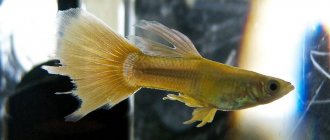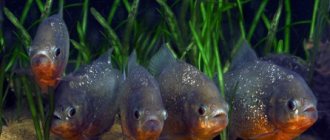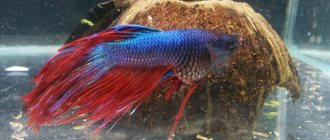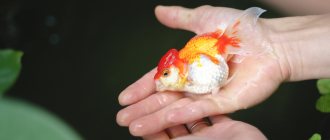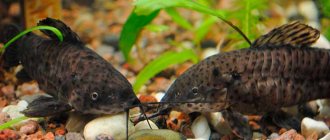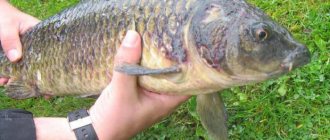Quickly navigate to the article
- 1 What diseases will it help with?
- 2 Rules for treatment with metronidazole
- 3 Hyperthermic treatment
- 4 Baths with trichopolum in a common container
- 5 Baths in a separate sedimentation tank
- 6 What drugs can metronidazole be combined with 6.1 Other interesting articles
Metronidazole is the active ingredient contained in the drug Trichopolum. An antimicrobial agent can be found in pharmacies. Tablets are widely used for the treatment of aquarium fish. They will help against various diseases. It is necessary to properly treat fish in the aquarium with metronidazole so as not to encounter problems later. It is recommended to follow the rules of therapy to achieve positive results.
What diseases will it help with?
The drug Trichopolum is often used for the treatment of aquarium fish. It helps fight protozoan parasites and internal bacterial infections. It is especially effective against parasites belonging to Hexamita. Excellent fight against hole disease in parrots.
Often aquarium fish are treated specifically for hexamitosis using metronidazle. This pathology is provoked by the intestinal parasite flagellate. It is able to penetrate the digestive system and gall bladder. Comes out with processed food. The danger is that all the inhabitants of the aquarium become infected.
Bacterial infection
Symptoms of bacterial infection in discus fish:
- In advanced cases, dehiscence (detachment) of the skin begins, and the lens of the eye becomes cloudy.
- They don't eat, they hide in corners.
- Discus fish with a bacterial infection have darkened and flattened fins.
- Discus fish cannot balance or bend from side to side.
- The mucous membrane thickens in some places, the edges of the fins become white, and gradual tissue destruction occurs.
Treatment of discus bacteria
In this case, treatment is carried out with the antibiotic Cifran, ciprofloxacin in combination with furazalidone.
Dosage: 1 tablet of ciprofloxacin/50 l of liquid, 1 tablet of furazalidone/10 l per day for 7 days. Don't change the water! From day 8 you can start changing H2O as usual.
Rules for treatment with metronidazole
Experienced aquarists recommend keeping fish in the highest quality water possible during treatment. Excellent aeration and filtration will be required. It is important to ensure that the water does not contain excess organic substances, ammonia, or nitrites. It is also worth noting that ammonia can become a significant problem when treating large fish. It can be solved by using ammolok or anti-ammonia.
During drug therapy, you should ensure that there are no high nitrates. Otherwise, it will not be possible to achieve positive results. If there is phosphate contamination in the tank, then the fish will be negatively affected.
Seven troubles - one answer
You can purchase the drug at a pharmacy, where it is sold without a doctor's prescription. The use of Trichopolum for spraying plants gives a positive result on cucumbers and tomatoes, as well as on any garden crops. There are a number of diseases for which this simple drug is a salvation:
- The first and main thing is late blight. The widespread scourge is destructive for all types of crops. Every summer resident knows how it manifests itself. Brown spots appear on the surface of the leaves. The cause is a fungus that spreads through spores. It is enough for it to appear in your neighbors’ garden, and under favorable weather conditions, your garden will also be under threat.
- The use of Trichopolum for plants in the country is also justified for the treatment of powdery mildew. Most often it affects cucumbers. The disease spreads very quickly, almost instantly. The leaf begins to turn yellow and fade, and a white coating appears on it. As a result, even if the plant does not die, the yield will deteriorate sharply.
- Another disease that this drug can help with is fusarium. The disease contributes to the formation of rot on plants and yellowing of leaves.
- Corner spot is another dangerous fungal disease. Most often it affects cucumbers. All leaves begin to dry out and die. Fruiting is reduced to a minimum.
Baths with trichopolum in a common container
Trichopolum cannot worsen bio-filtration processes in the aquarium. For this reason, you can add the product to the container itself. There is no need to move individuals to another container to carry out treatment.
You will need to use 0.25 grams of the drug per 35 liters of water. During the first 3 days, the medication is used once after a partial change of liquid in the container. Then the drug is used once every two days. The course lasts up to 2 weeks. If the condition of the fish gets worse, then you will have to abandon the drug.
Symptoms of hexamitosis
The presence of this disease in a discus can be detected by carefully monitoring both its behavior and its state of health:
- Hexamitosis in fish is often accompanied by transparent whitish and thread-like, and sometimes stringy, feces. This happens for the simple reason that the cells of the intestine or gallbladder begin to be rejected en masse, “coming out” along with a large amount of viscous mucus. You may also encounter another variant of disruption of the digestive tract in discus fish: almost all the food is released in an indigestible form along with excrement.
- Reduced need for food. And in severe cases, discus fish completely refuse it. In a milder stage of hexamitosis, the pet “spits” food, that is, it repeatedly takes a piece of food into its mouth and then spits it out. It is for this reason that most aquarists consider discus to be a very selective fish species, they say that they try food and if they don’t like it, they spit it out. It has been clinically proven that the imaginary gastronomic “selectivity” disappears, as soon as proper treatment with metronidazole is carried out.
- Sometimes intestinal bloating is observed, to a greater extent this applies to fish of the cichlid and apistogramma genus. However, the phase of abdominal enlargement is not always present in the development of this disease. Most often, discus fish begin to lose weight, after which their belly takes on a peculiar keeled or concave shape, and the back dries out.
- Hexamitosis can be characterized by darkening of the color of an individual, as well as its separation from its “cohabitants”.
- Violation of the integrity of the skin. In most cases of this disease, erosions and ulcerations of the integument of the head part, as well as changes in the appearance of the lateral line, were noted. In healthy fish this line is almost invisible, while in infected fish it takes on a clearer outline, turns white and becomes a little wider. Quite often, rather deep holes appear on the skin of a sick individual, mainly on the head and at the beginning of the lateral line, accompanied by the release of a white mass. Depending on the size of the fish, the size of these holes can vary from 1 mm to 1 cm in circumference.
A few nuances
I would like to note that the above symptoms of hexamitosis do not always appear in the specified order and in full. As a rule, most of the literary publications that cover this topic put the symptom, which, most often, is the initial one, on a kind of “pedestal”. In general, the above symptoms correspond to reality, although sometimes the disease may appear not from the first symptom on our list, but immediately from the fifth.
I would also like to note the fact that transparent white and thread-like feces are not always a 100% guarantee that your pet is sick with hexamitosis and other diseases that are associated with intestinal parasitic creatures. There are many other ailments that have similar symptoms.
For example, intestinal inflammation can be characterized by intoxication of the body or a banal overeating of fatty foods. With helminthiasis, coccidiosis enteritis and other diseases of this kind, fish increments have a thread-like shape.
But be that as it may, a violation of the discus’ “stool” indicates that his health is not all right, so it is still better not to postpone quarantine and other treatment and preventive measures until the true cause of the pet’s illness is clarified.
Remember to monitor your waterfowl's behavior at least once a day. It’s not difficult to stop at the aquarium for a few minutes and observe the behavior of the fish. And besides, such an activity will not only help to avoid infection of all individuals in the “water house”, but will also have a positive effect on your nervous system, calming it.
What drugs can metronidazole be combined with?
Trichopolum can be combined with ciprofloxacion, keeping the proportions of 0.5 grams per 50 liters of water. In addition, the medication can be used together with rifampicin. It is taken in a volume of 0.15 grams per 50 liters.
You can combine metronidazole with Baktopur Direct. This is required to clean the fish of parasites. In addition, it will be possible to get rid of bacterial diseases.
In any case, treatment must be competent and timely. It is necessary to use the medicine metronidazole in a strict dosage in the aquarium. Only in this case will it be possible to avoid negative consequences and improve the well-being of the fish.
Other interesting articles
- Varieties of aquarium fish The number of varieties of aquarium fish is in the thousands, and each of them has its own characteristics. Agile and...
- Treatment of fish with Bicillin 5 in a community aquarium The proposed method of treatment with Bicillin-5 completely frees fish from the causative agents of the following diseases: ichthyophthyriasis, trichodinosis, chylodonellosis,…
- What fish can live without aeration, air in the aquarium? What fish can survive without oxygen and filtration? No living creature can live without...
Why do discus get sick?
First, the discus fish suffered all the negative consequences of the selection process. The closest, perhaps, to its natural form is the brown discus, which few people keep today. But in vain... The beauty of the brown discus must be seen. It is not so bright, but its beauty lies in the severity of the coloring. However, this is another topic...
The second reason is a change in environmental conditions: an aquarium is not the Amazon. Despite the different composition of water in the Amazon for discus, it is mostly acidic and soft. And acidic water is known to inhibit the development of bacteria.
In the case of an aquarium with discus fish, we most often deal with tap water, which, according to the regulations, simply cannot be acidic. And its rigidity, even in the most “soft-water” regions, is greater than that of the Amazon. Thus, having imprisoned beauty in an aquarium in an unnatural environment for it, it is logical to be prepared for diseases. And they happen. But what is really in our power is to reduce them to a minimum or “nip them in the bud.”
Disease Prevention
With careful attention to the discussion, compliance with the rules and conditions of detention, an outbreak can be avoided or localized in time.
- Do not allow the temperature to drop below 29 C, monitor the water quality.
- Do not allow pathogenic microorganisms to enter a dish containing live food, plants, or soil from natural bodies of water.
- Feed high quality, varied, well-balanced foods
- Sift (siphon) the soil 2-3 times a month
- Purpose of individual equipment
- Put away sick animals at the appropriate time
- Conduct daily visual inspections
- Timely transplant
- Remember about filters, aeration
- Do not transfer parasites from contaminated bodies of water to healthy ones.
- Remove droppings and food debris in a timely manner
- Don't put large numbers of fish together
Sources:
- https://AkvaOK.ru/presnovodnye/rybki/bolezni-diskusov.html
- https://aqua-south.ru/kak-lechit-rybok-metronidazolom-v-obshhem-akvariume/html
- https://discus-club.ru/bol.html [collapse]
Side effects and features of administration
The most common violations:
- Gastrointestinal tract: abdominal discomfort, nausea, vomiting, impaired taste perception (“metallic” taste in the mouth), diarrhea;
- immunity: anaphylactic shock, angioedema;
- skin: rash, itching, urticaria;
- genitourinary system: change in the color of urine up to a reddish-brown color, candidiasis.
The drug crosses the placental barrier, which completely limits its use in the first trimester of pregnancy. In the second and third trimester, metronidazole is used if the estimated risk to the fetus is lower than the possible benefit to the pregnant woman. Treatment of a lactating woman requires cessation of breastfeeding.
When treating trichomoniasis, it is necessary to carry out therapy simultaneously in both partners and to exclude sexual contact for the period of therapy.
Gill or skin flukes in discus fish
Called monogenic flukes, they require only one host to complete their life cycle. These are common parasitic worms (ectoparasites) about 1-2 mm long that live and reproduce in the gills of tropical fish. Due to their small size they are barely noticeable.
The gill filaments have tiny hooks that attach to the gill filaments. A large number of parasites leads to the formation of mucus plugs, due to which the gill covers stick together. This leads to a deterioration in oxygen consumption, the fish becomes lethargic and quickly dies due to bacterial infection or oxygen starvation.
Symptoms of discus regrowth paralysis:
- Discus stops eating.
- The gills swell and the gill covers become swollen.
- Affected by monogenic flukes, fish become shy, restless, rub against the decorations, become isolated, and sometimes show symptoms of lethargy.
- Sometimes one of the covers freezes and stops moving.
- An infected individual may suffocate on the surface or lie on the bottom with its fins tightly pressed to its body.
Correct diagnosis is only possible with skin scraping or gill biopsy.
Treatment options for gill or skin fluke infestation
Treatment is carried out in another aquarium at a temperature of 28 C and enhanced aeration, but without plants, substrate, or filter. The fish is placed in it 24 hours before the start of treatment.
Numerous anti-gillworm treatments are added to the water, but they only affect hatched organisms—worm eggs are extremely resistant. Several treatments are required over several weeks.
Tremazolom treatment - dose 1 ml / 15 l of water, after 6 hours replace 80% of the liquid, after a week the process should be repeated.
Additional aeration is required, the UV lamp is turned off, the biological filters remain in working order.
Gyrodol is a similar treatment, dose 10 ml/40 l, the drug is dangerous for shrimp.
Foreign aquarists use the following treatment methods to treat discus fish:
Formaldehyde treatment. This method is very risky, but the most effective. The dosage and duration of the procedure vary. Dosage 1 ml of formalin (formaldehyde) per 40 liters of liquid, after 8 hours replace 50% of the water, the temperature does not increase, additional aeration is required, remove carbon filtration during treatment, do not turn on the light bulbs, if after the first dose the condition clearly improves, you can continue the procedure daily for 2 weeks.
Formaldehyde is a poison that should be handled with care:
- Do not use formaldehyde with sediment due to its high toxicity.
- Always wash your hands after use
- Do not store the product in the refrigerator.

